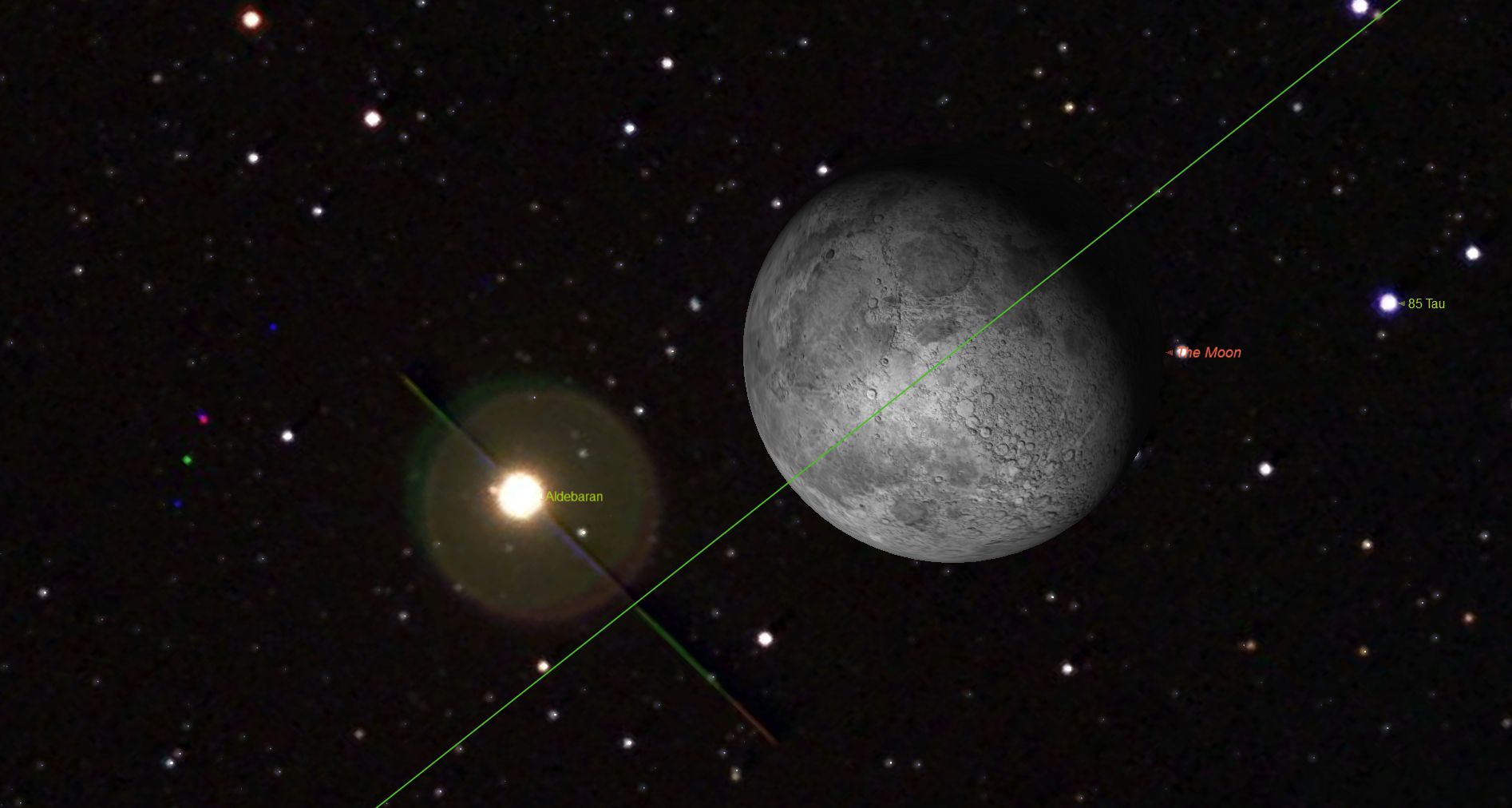Moon Hits Bull's-Eye Tuesday in Vivid Aldebaran Crossing

The waning moon will cross in front of one of the brightest and most colorful stars in the sky on the night of October 18-19 for viewers in the southern and eastern United States, and part of eastern Canada.
Late Tuesday night (Oct. 18), users of even the smallest telescopes will be glued to their eyepieces as the edge of the waning gibbous moon, 85 percent illuminated, occults the 1st-magnitude star Aldebaran, which forms the bright orange eye of Taurus, the Bull.
We're currently in the midst of an almost four-year series of Aldebaran occultations. Every month as the moon circles the Earth it passes in front of the star as seen from some part of the world. On the night of Oct. 18-19, the lucky region includes anywhere south of a line running from Los Angeles to about 50 miles south of Las Vegas, through Denver, to 30 miles southeast of Minneapolis, then northeast to Ishpeming Township, Michigan, and continuing to George's Island, Labrador. If you are north of this line (which includes the Pacific Northwest, northern and central California, northern and central Rockies, northern and central Plains), the moon will pass tantalizingly close to Aldebaran, but will not cover it. Observers right on this line, probably less than two-tenths of a mile (three-tenths of a kilometer) wide, will be able to watch Aldebaran graze the bright limb of the moon. [Planets, Constellations and Orionid Meteors In Oct. 2016 Skywatching (Video)]
Many observers will aim smartphones and camcorders at their eyepieces to capture a video of the event while shortwave radio time signals play in the background. That setup will allow viewers to time the instant when the star vanishes behind the moon's limb, and when it reappears later from behind the other limb, to a few hundredths of a second.
The International Occultation Timers Association (IOTA) has set up a special web page for the upcoming Aldebaran graze, complete with maps, predicted lunar-limb profiles and other information.
When to look
For prospective viewers in Southern California, Aldebaran will disappear soon after 10 p.m. PDT. In the eastern U.S., it will happen between 1 and 2 a.m. EDT. The star will disappear on the moon's bright side and reappear on the dark side.
As the moon, three days past full, ascends the eastern sky, Aldebaran will appear to creep up to the moon's bright limb for many minutes, then hang on the sunlit edge of a few seconds — an eerie orange fire among the lunar hills. You'll need a telescope to see it there through the moon's glare. Then, in an instant, it will snap out of view.
Breaking space news, the latest updates on rocket launches, skywatching events and more!
Aldebaran will reappear from behind the moon's dark portion (depending on your location) up to 75 minutes later. This time you may be able to see the event with binoculars, since the star will pop back into view farther away from the dazzling lunar surface.
Detailed predictions
IOTA has also created a web page depicting the entire viewing zone (which includes parts of Africa and Europe) and a listing of disappearance and reappearance times for over 1,000 locations — including nearly 300 in the United States.
For example, what can you expect to see from a rooftop in Philadelphia? The City of Brotherly Love is location #920. The listings are in Universal Time; for Philadelphia this is 5:41:05, which corresponds to 1:41:05 a.m. EDT. At that time, the moon will be 54 degrees high at an azimuth of 122 degrees, corresponding to 32 degrees south of due east. The position angle (PA) is 48 degrees, measured counterclockwise from the top of the moon. This gives the position along the moon's limb where Aldebaran will disappear.
So 0/360 degrees = 12 o'clock; 90 degrees = 9 o'clock; 180 degrees = 6 o'clock; 270 degrees = 3 o'clock.
In this case, if the moon was the face of a clock, 48 degrees would correspond to between 10 and 11. For the reappearance: 6:47:39 UT (2:47:39 a.m. EDT); Altitude 64 degrees; Azimuth 148 degrees (SSE) and the PA is 284 degrees.
The U.S. Nautical Almanac Office provides an alternate occultation visibility map here.
Halfway done
As I noted earlier, the current series of Aldebaran occultations runs for nearly four years. The current series began Jan. 29, 2015, with an occultation visible from the Arctic regions. The next Aldebaran occultation visible from North America (and Hawaii, too) will come on the night of Dec. 12-13. The series will come to an end Sept. 3, 2018, for Greenland and the Arctic regions. After that, we must wait until Aug. 18, 2033, for the series of Aldebaran occultations to begin.
Joe Rao serves as an instructor and guest lecturer at New York's Hayden Planetarium. He writes about astronomy for Natural History magazine, the Farmer's Almanac and other publications, and he is also an on-camera meteorologist for News 12 Westchester, New York. Follow us @Spacedotcom, Facebook and Google+. Original article on Space.com.

Joe Rao is Space.com's skywatching columnist, as well as a veteran meteorologist and eclipse chaser who also serves as an instructor and guest lecturer at New York's Hayden Planetarium. He writes about astronomy for Natural History magazine, Sky & Telescope and other publications. Joe is an 8-time Emmy-nominated meteorologist who served the Putnam Valley region of New York for over 21 years. You can find him on Twitter and YouTube tracking lunar and solar eclipses, meteor showers and more. To find out Joe's latest project, visit him on Twitter.
